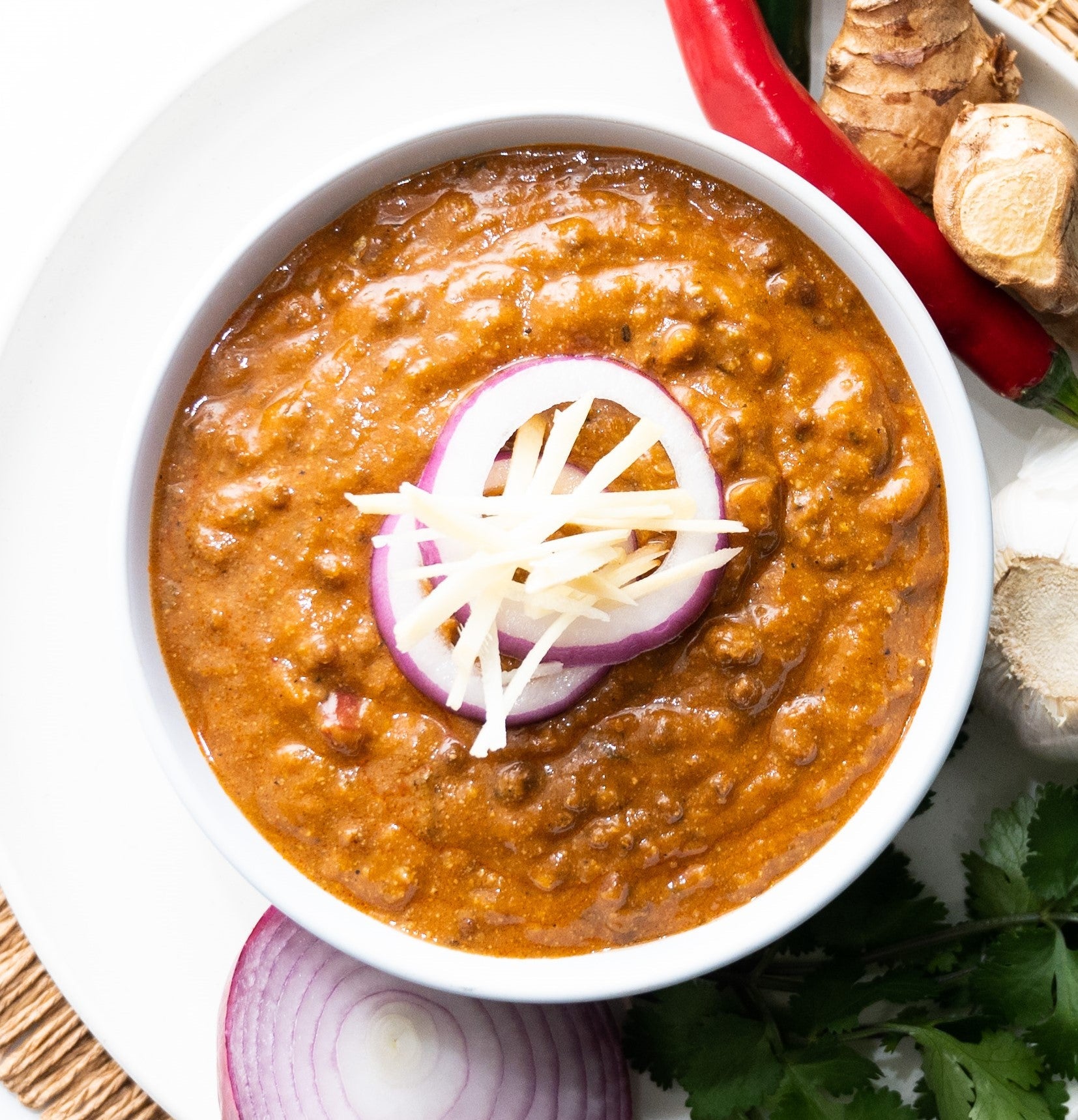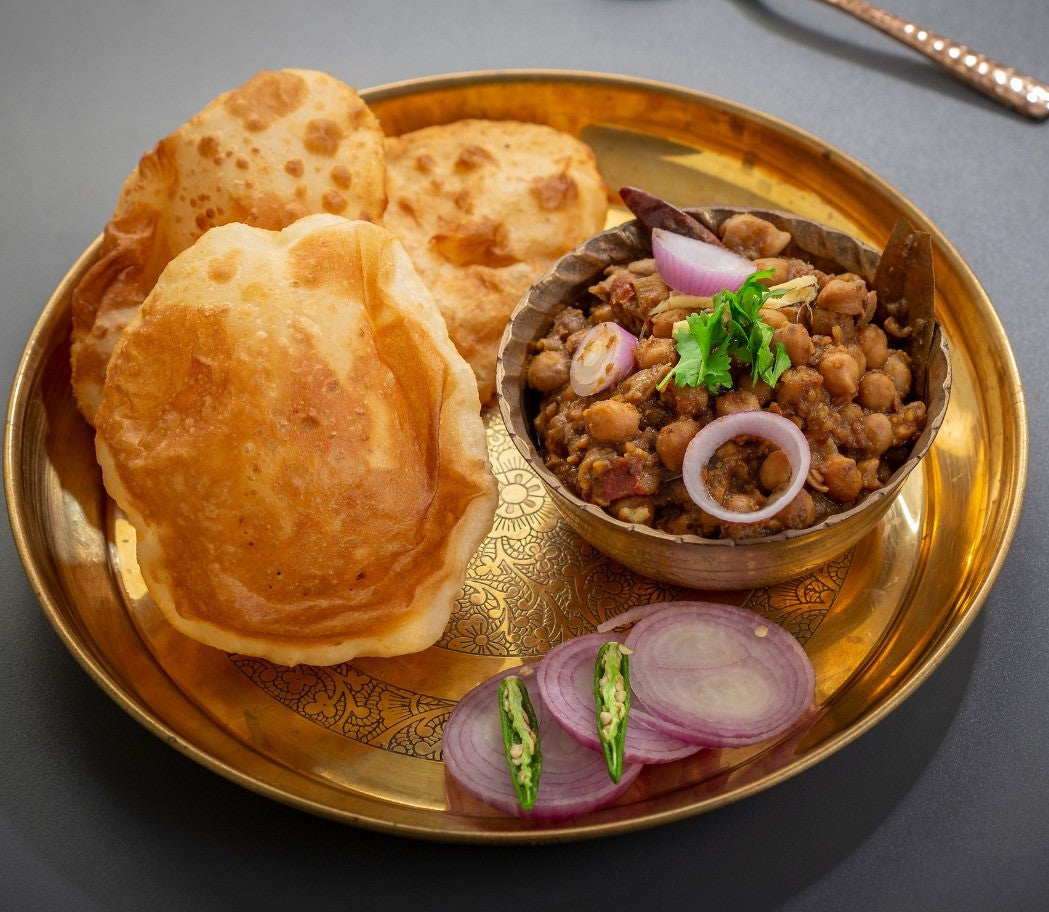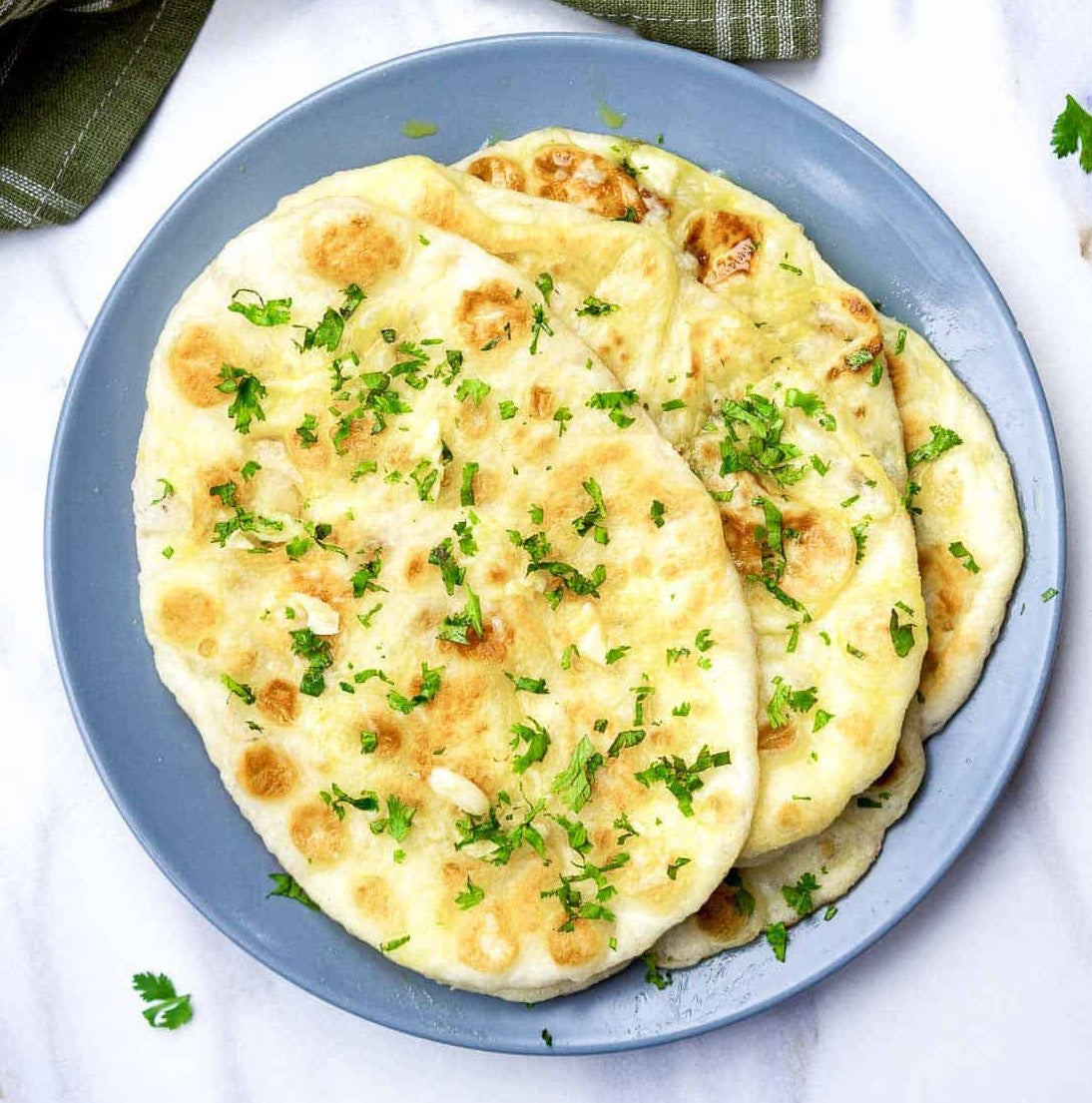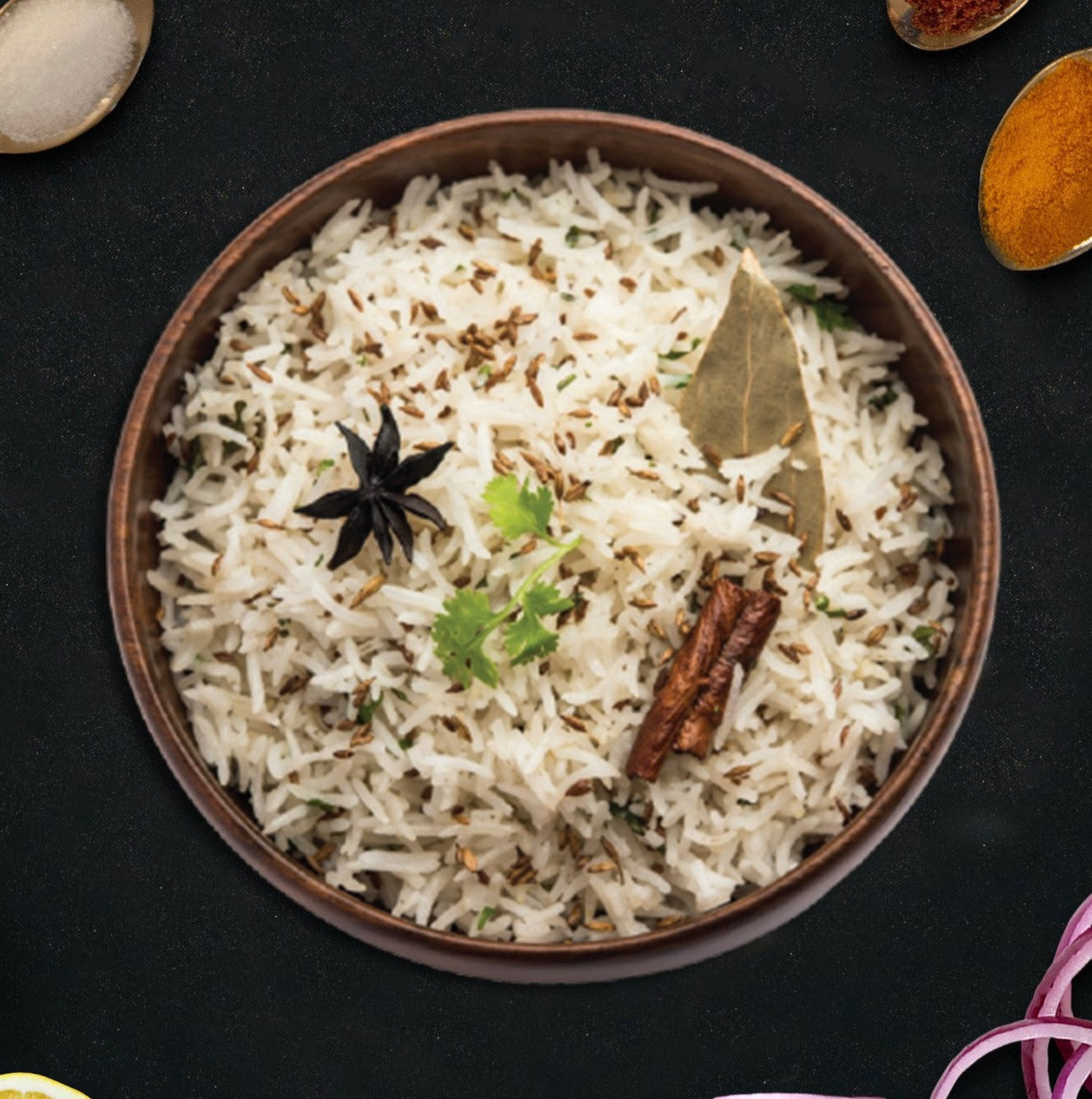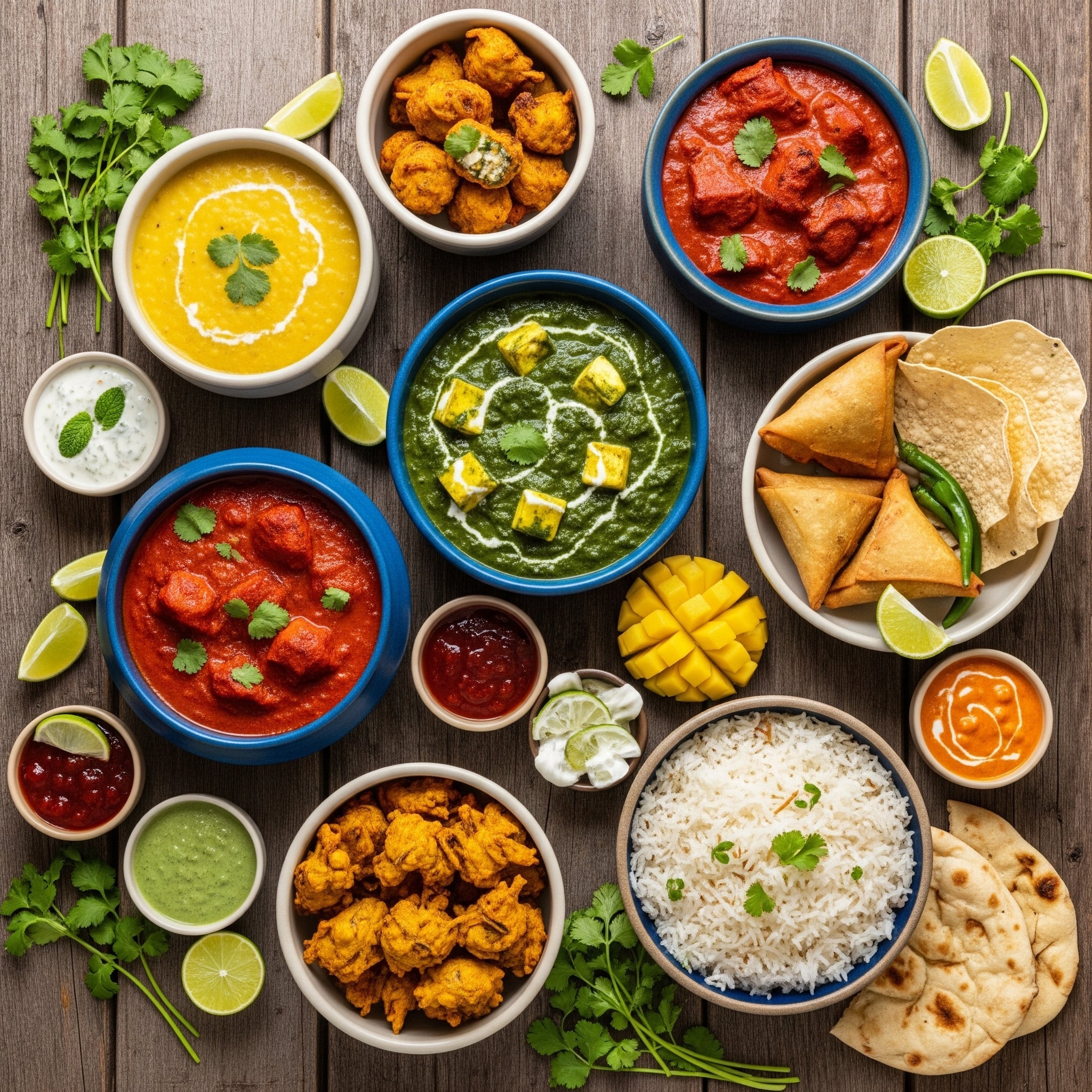
How to eat healthy on a budget: Aussie Guide
Most Aussies assume eating fresh and healthy stretches the shopping budget. But if you swap impulse buys for a plan, you can bring your fortnightly spend down to AUD 730 instead of AUD 864.
Cost Comparison Of Australian Diets
Crunching the numbers shows a clear advantage for a well-planned, nutritious shop.
- Typical fortnightly spend in Greater Brisbane: AUD 863.93
- Healthy basket cost per fortnight: AUD 729.71
- Bi-weekly savings: AUD 134.22 (about 15%)
Knowing these figures makes budgeting for real food feel much less daunting.
Why Planning Slashes Costs
Taking 30 minutes to sketch out a two-week menu stops impulse purchases in their tracks. Seasonal fruit and veg not only taste better but come with friendlier price tags. Stocking up on pantry basics in bulk slices the per-serve cost dramatically.
- Base your menu around weekly deals and sale items
- Compare unit prices to catch genuine bargains
- Download store loyalty apps for exclusive discounts
Impact Of Habitual Vs Healthy Baskets
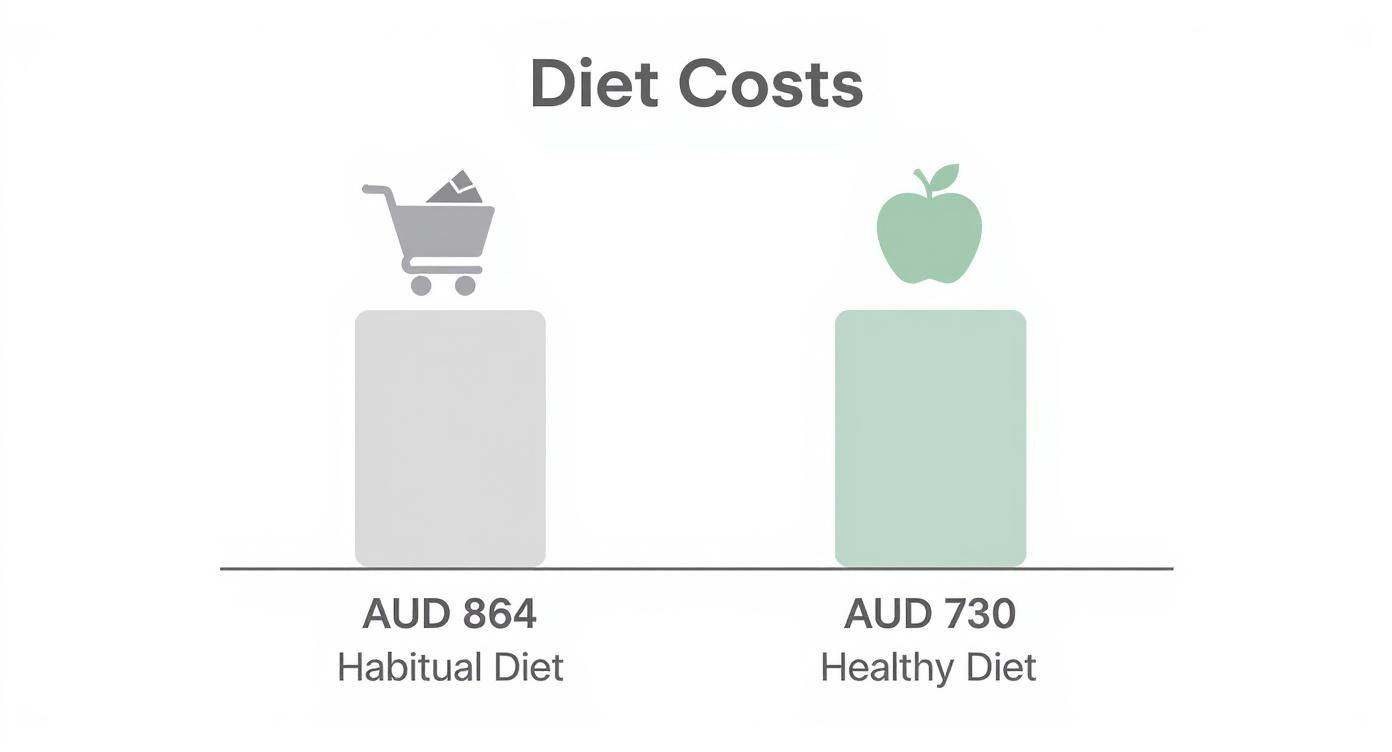
This graphic highlights roughly a 15% reduction in costs when you opt for a curated healthy basket. In fact, a 2022 study in Greater Brisbane found the habitual diet was 18.4% pricier than its healthy counterpart.
Learn more in the PMC Study on Brisbane Diets.
Shifting to a planned healthy basket can save your family AUD 268 every month while boosting nutrition.
Healthy Diet Vs Habitual Diet Fortnightly Cost Comparison
Here’s a quick look at how costs stack up over a fortnight when you choose healthy ingredients over habitual favourites.
| Diet Type | Average Fortnightly Cost (AUD) | Potential Fortnightly Savings (AUD) |
|---|---|---|
| Habitual Diet | 863.93 | – |
| Healthy Diet | 729.71 | 134.22 |
Switching to a healthy basket could trim about AUD 134.22 off your bi-weekly grocery bill.
Selecting Budget-Friendly Staples
Focus on versatile, low-cost ingredients that stretch every dollar without sacrificing nourishment.
- Dried lentils: roughly 25 servings per kilo at under AUD 0.60 per serve
- Rolled oats: use in porridge, smoothies or baking for easy fibre boosts
- Frozen mixed vegetables: lock in vitamins and last for months without spoilage
Even swapping just one item in your usual shop can shave dollars off your fortnightly total.
Taking Charge Of Your Shopping
Arrive with a concise list to dodge unplanned aisle detours and impulse grabs. Lean into value packs or own-brand alternatives to keep quality high and costs down.
- Stick to store price tags and unit cost checks
- Abide by your list and avoid those tempting end-cap displays
Simple Next Steps
- Review your last two fortnight spends and pinpoint three items to replace with cheaper, nutritious alternatives
- Build a fresh two-week meal plan centred on legumes, oats and seasonal produce
Build Your Budget Around Your Kitchen
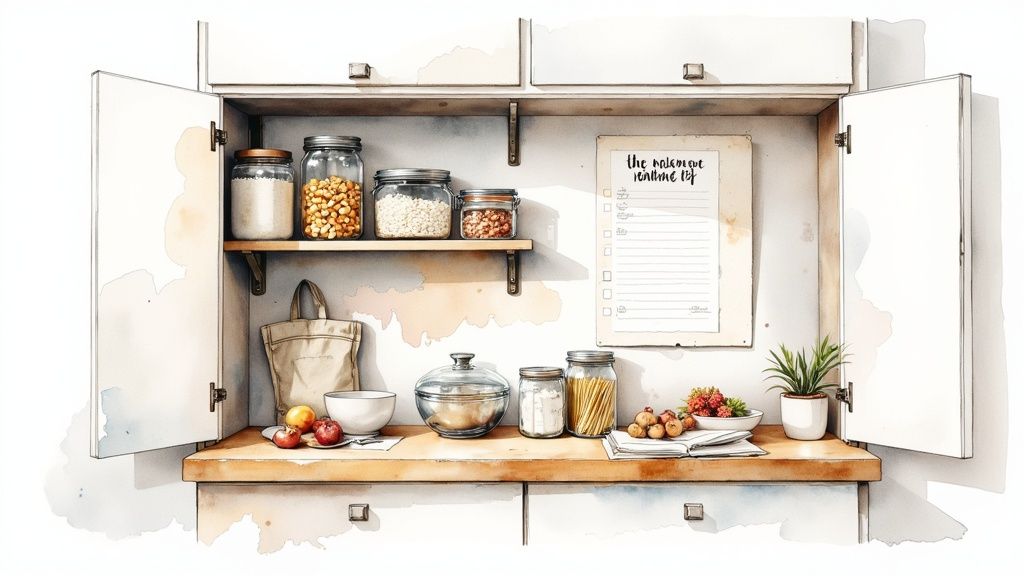
Your kitchen isn’t just where dinner happens—it’s the command centre for your grocery budget. Before you shop, take stock of every jar, packet and frozen bag. That simple ritual can stop repeat buys, slash waste and save you $50 or more every month.
Conduct A Pantry And Freezer Audit
Line up tins, grains and frozen veggies so nothing hides at the back. Check best-before dates on sauces and condiments to dodge spoilage. Then jot down herbs, spices or staples that are running low.
• Scan best-before dates across all tinned goods and condiments.
• Group similar items together (grains, beans, frozen veg) for a clear overview.
• Note any loose spices or herbs you’ll need to top up.
Once you’ve mapped your inventory, you’ll know exactly what meals to build for the week—no guesswork, no extra spend.
Map Out Flexible Meal Plans
Watch your local shop’s specials and plan around the best deals. Say roast chicken hits $8 on Wednesday—grab two. Use half for a Sunday roast dinner with seasonal veg, then turn leftovers into:
• Monday sandwiches with shredded chicken and salad.
• Tuesday bone broth or vegetable-packed soup from what's left.
Suddenly one sale item stretches into three hearty meals without any panic-buying.
Maximise Weekly Specials And Seasonal Produce
Flyers land on Tuesday—treat them like treasure maps. Spot the cheapest veg and pair with pantry staples to keep meals under AUD 5 per serve.
• Bulk carrots and potatoes keep fresh for weeks at around $1.20/kg.
• Seasonal greens—like kale or broccoli—often dip below $2 a bunch.
Local markets can be goldmines for fresh picks at lower prices. And if you’ve got a windowsill or balcony, consider easy home growing—you’ll find tips on easy edible indoor plants for year-round harvests.
“Running regular pantry audits can cut your grocery waste by up to 30% over three months.”
Repurpose Leftovers Into New Meals
Yesterday’s roast vegetables? They become today’s frittata or grain bowl in minutes. Cooked rice or quinoa mixed with beans, herbs and a squeeze of lemon turns into a zesty salad. This habit can chop your meal prep time by 25% and keep waste out of the bin.
Check out our guide on finding an Indian market near you to stock up on authentic spices and bulk staples.
Running these routines can save a family of four around AUD 200 every month. Those extra dollars can go towards fresh fruit, a gourmet spice jar you’ve been eyeing or simply padding your savings.
When evenings get hectic, pick up a Student Deal from Jewel of Asia at $9.99 a meal. Bulk Catering Packs are also a savvy way to cut per-serve costs for gatherings or make-ahead dinners.
Create Repeatable Systems
Consistency is where real savings live. Block out half an hour each weekend to audit your pantry and sketch out the coming week’s meals. Keep a notebook of wins and tweaks—over time you’ll perfect portion sizes and pairings so it all flows smoothly.
Real-world example: One busy family swapped two takeaway nights for home-cooked plans and put AUD 100 back into their budget. They reinvested in extra veggies and a small herb pot—and suddenly every meal tasted of homegrown flair.
Your kitchen has just become your budget’s best ally. Go forth!
Mastering The Art Of Grocery Shopping
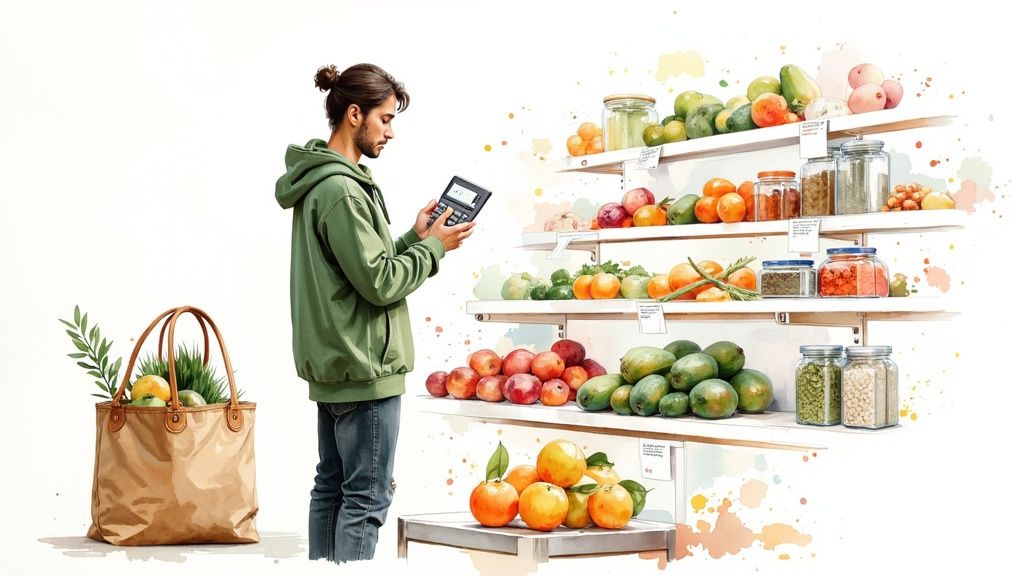
Once you start reading the price per 100 g or per litre, those flashy deals make sense. Suddenly, you know which items are genuinely on sale and which ones are just dressed up with big tags.
Take tomatoes, for instance. At your local farmers market they can be $3/kg on a sunny Saturday morning, while the same batch at a supermarket might cost $5/kg. That’s a neat 40% saved on peak-season produce.
Compare Shopping Venues
| Venue | Strength | Cost Factor |
|---|---|---|
| Farmers Market | Fresher seasonal picks | Higher per kilo |
| Bulk Store | Cheapest unit price | Upfront investment |
| Local Supermarket | Convenience and offers | Moderate promos |
Mix and match your outlets:
- Stock up on grains, pulses and oats at bulk stores.
- Grab salad greens and heirloom veggies at markets.
- Snatch weekly specials at supermarkets.
Use your phone to scan shelf labels or barcode-scanning apps. They’ll spit out the unit price and compare nearby stores in seconds. Top picks include ShopSavvy and Frugl. And don’t forget loyalty schemes like Flybuys or Everyday Rewards—they tuck extra vouchers into your shopping cart.
To streamline healthy shopping, check out shopping at major Australian supermarkets like Woolworths for current student and family deals.
Use Loyalty And Digital Tools
Apps take the legwork out of hunting bargains. Load up on free loyalty cards to rack up points and snag personalised coupons. Many digital platforms let you stack coupons on sale tags for deeper cuts.
Small digital savings add up to $200 a year.
Peek at your app before heading out. You’ll spot which specials to chase and can tweak your grocery list around the best deals.
Swim Through Seasonal Deals
When produce is in season, it’s often 20% cheaper and bursting with flavour. Right now in Australia, citrus, spinach and carrots are at their peak.
Visit farmers markets on weekend mornings to grab box deals for $15 or less. Bulk-buy apples and bananas on supermarket sale racks for as little as $1.50/kg. Then chop, bag and freeze extras to keep waste down and smoothie prep quick.
Visiting an international grocery store can unlock new staples at wallet-friendly rates. You might snag chickpea flour and spices in bulk for a fraction of supermarket prices. Check out our guide on finding international grocery stores near you for insider tips.
Plan Around Weekly Flyers
Every Tuesday, new flyers land with multibuys and bonus point offers. Circle proteins, canned goods and frozen veg that fit your menu plan. Comparing specials at Coles, Woolworths and Aldi can slash your bill even more.
Fit these deep-discount items into recipes you already love—tuna pasta, curry stews or veggie-packed soups.
Balancing Cost And Convenience
Supermarket home brands often rival big names but cost a fraction. Cooking beans and grains in large batches beats single-serve packs every time. Yet when evenings get hectic, ready-to-eat options are a lifesaver.
Jewel of Asia Student Deals start at $9.99 with free shipping. Their Catering Packs make weeknight dinners almost effortless.
Real Life Supermarket Example
Emma shops for four and walks away with an extra $50 in her wallet by making a few simple swaps:
- She reads unit-price tags and grabs a 1 kg block of cheese instead of four 200 g packs.
- She treats end-cap displays as suggestions, not impulse triggers.
- She syncs Woolworths app discounts into her trolley.
- She pairs carrots with homemade hummus for a zero-waste snack.
- She chops, labels and freezes bananas in smoothie-ready portions.
- Balancing fresh and frozen produce drives her meal cost down to under $6 per serve.
Emma then leans on weekly flyers to plan three different salads. Beans, seasonal leaves and tossed seeds keep the rotation interesting—no single salad lasts more than two days.
Her top tip? Introduce one new tactic each shop and track how much you save.
Key Takeaways
- Decode Unit Price For True Value
- Shop Seasonally To Cut Produce Costs
- Leverage Loyalty Apps And Flyers
- Mix Venues To Match Quality And Budget
This is a strategy you build over time, not a one-and-done trick. Try one extra price check or download a new app this week—see how much you can keep in your pocket while eating well. Happy shopping!
Cooking Techniques That Stretch Your Dollar
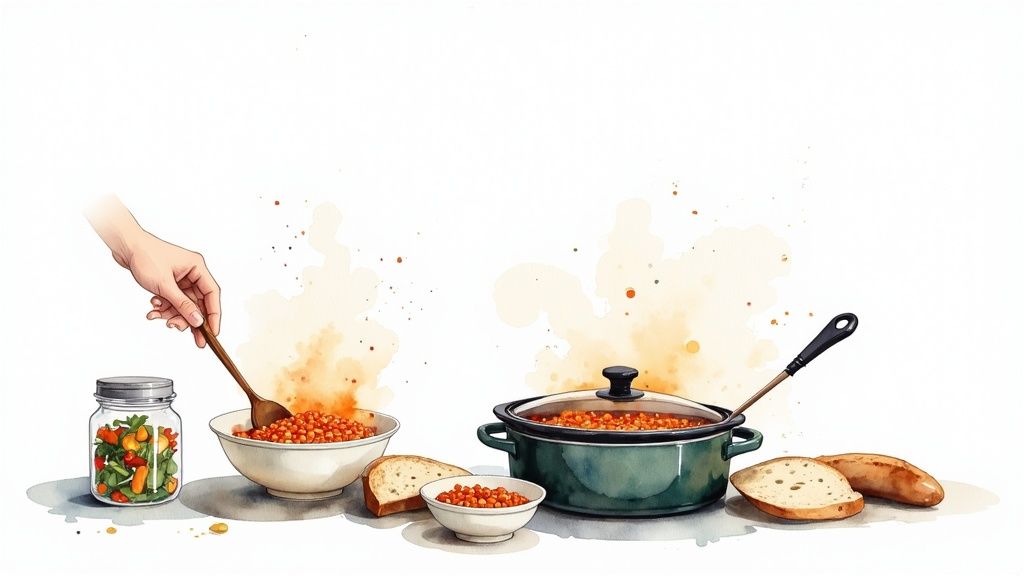
Batch cooking is more than a timesaver—it’s a way to lock in nutrition while cutting costs. Spending an hour on a weekend to cook a large pot means you’ll have ready meals all week. Many home cooks report it slashes prep time by 30%, so you can spend more on fresh fruit and veg.
Sunday Prep Guide
- Pick two budget-friendly proteins like chicken thighs or dried beans.
- Chop a mix of in-season vegetables—think carrots, capsicum and pumpkin.
- Divide portions into freezer-safe containers for quick midweek dinners.
- Label each box with the date and contents to keep track of freshness.
Batch Cooking Benefits
For example, imagine a family of four simmering a big pot of chilli with mincemeat, canned beans and tomatoes. That single batch can stretch into 6 meals at under $3 per serve. On top of that, having meals ready at home stops those $15 takeaway cravings on hectic nights.
- Save about AUD 50 a month by avoiding convenience-food splurges.
- Guarantee balanced plates by planning protein, vegies and grains ahead.
- Cut impulse buys when you’re starving and short on time.
Tender Meals From Cheap Cuts
Tougher cuts like beef chuck or pork shoulder transform beautifully when cooked low and slow. A slow cooker or a heavy pot on the stove brings out rich flavour and melts the meat almost to the point of falling apart. You’ll enjoy hearty stews for as little as $4 per serve.
- Brown the meat in a splash of oil to deepen the taste.
- Toss in aromatic vegetables and a handful of herbs for extra complexity.
- Pour in stock or water until the meat is just covered, then cook for 6–8 hours.
- Shred the finished meat and mix with grains or pasta to stretch every last bite.
| Ingredient | Cost Per Kg (AUD) | Servings Per Kg | Cost Per Serve |
|---|---|---|---|
| Beef Chuck | 8.00 | 4 | 2.00 |
| Pork Shoulder | 7.50 | 4 | 1.88 |
| Lentils (dried) | 4.00 | 16 | 0.25 |
Bulk Up With Lentils And Beans
Lentils and beans are protein-packed, cheap and endlessly adaptable. Stirring a cup of cooked lentils into a curry or soup not only boosts fibre but also expands your dish. Typically, beans land under $1 per serve compared to $2–4 for meat.
- Swap half the mince in your Bolognese for lentils to trim costs by 25%.
- Stir beans into casseroles for extra texture and nutrients.
- Blend cooked beans into burger patties for a moist, high-protein twist.
Beans and lentils are nutritional powerhouses that can slash your grocery bill without cutting flavour.
Zero Waste Tricks
Turning veggie trimmings into homemade stock can save roughly AUD 10 each month. Just freeze peelings, ends and stalks. When you’ve got a jar full, boil with herbs, strain and pour into ice-cube trays for easy flavour bursts.
- Freeze carrot tops, onion skins and celery bits instead of tossing them.
- Revive wilted greens by soaking in ice-cold water for a few minutes.
- Dry herb stems in a jar to season soups and sauces later on.
- Crisp up stale bread in the oven for fresh breadcrumbs.
Embracing these zero-waste habits keeps meals tasting vibrant and your budget intact.
One Pot Meal Ideas
Fewer dishes, lower energy bills and deeper, melded flavours. That’s the beauty of one-pot cooking. Here are a few crowd-pleasers that unite protein, veg and grains:
- Mexican rice with black beans, corn and warming spices.
- Moroccan-style chickpea and carrot stew in a tomato base.
- Thai coconut curry loaded with tofu, pumpkin and spinach.
- Pasta primavera tossed with whatever veges you have on hand.
Most of these options come in at under $5 for four hearty servings. Feel free to swap ingredients based on specials or pantry staples.
Shelf Life Hacks
Storing produce correctly can rescue AUD 20 a month from slipping into the compost bin. A few simple tweaks make all the difference:
- Keep mushrooms in a paper bag to prevent soggy, slimy caps.
- Wrap fresh herbs in a damp paper towel before popping them into a sealed bag.
Adopt these cooking techniques and you’ll see your grocery bill drop—while enjoying more variety and flavour. All it takes is a bit of planning and creativity to turn your kitchen into a budget-friendly powerhouse.
Healthy Eating On Your Busiest Days
Some evenings, cooking feels like the last thing you want to tackle. That’s where ready-to-go kits and frozen meals come in handy. Keep a stash of affordable, nutritious options to dodge pricey takeout and time-wasting decisions.
• Stock three frozen stir-fry packs or grain bowls for under $5 each—heat in minutes.
• Portion chicken, tofu or beans into zip-lock bags so sautéing takes seconds.
• Pre-chop veggies in airtight containers to slash prep time and cut waste.
These simple setups banish decision fatigue. Grab, heat and eat before the evening rush takes over.
Quick Prep Strategies
A few smart swaps can turn bulk cooking into stress relief. A $10 rice cooker makes enough grains for five lunches. Mix a handful of spinach, frozen peas and a boiled egg for a five-minute bowl.
• Roast a tray of veggies on Sunday night—keep them fresh for 3 days.
• Microwave or toss cold into salads for instant sides.
“Having a stash of ready-to-eat components cut our delivery orders by 80% in one month.”
Busy students and professionals often lean on Student Deals from Jewel of Asia. At $9.99 per serve, preservative-free curries are ready in minutes. Catering Packs deliver bulk meals that freeze well, costing as little as $4 a portion.
Smart Takeaway Substitutes
You don’t have to miss out when you’re on the go. Aim for meals under 600 calories with at least 15 g of protein. Many sushi packs, grilled chicken salads or veggie soups fit the bill—and often come in under $12.
• Pick a pre-made salad kit and boost protein with a tin of salmon.
• Choose meal boxes that list macros on the label to track nutrients.
• Compare unit prices online so you spot genuine bargains.
Learn more about convenient options in our guide to the best ready meals in Australia.
Plan Your Restock Routine
A simple restock habit stops last-minute splurges. Jot down your meal pack count on the fridge each evening. Refill frozen meals or JOA Catering Packs during weekly shops or online.
• Note items running low and set phone reminders when you hit three.
• Schedule quick grocery runs or bulk orders around these alerts.
Frequent restocks cut emergency orders by 70% according to busy urban households.
Seeing a full freezer and fridge transforms meal stress into planning peace. You’ll save time, trim costs and maintain nutrition—day after busy day.
Why Your Food Choices Matter for Australia
Fortnightly kitchen habits drive more than wallet savings—they shape our health and the country’s future. Smart meal prep, savvy shopping trips and simple cooking hacks add up. Over time, they help Australians sidestep chronic illnesses linked to poor diets.
Diet-related poor nutrition costs Australia about AUD 16.2 billion every year. We could lighten that burden by choosing better foods today. Learn more about these findings on Dietitians Australia.
Small steps in the kitchen can make a huge impact on Australia’s health system.
Empower Long Term Health
Eating thoughtfully keeps heart disease and type 2 diabetes at bay. It also boosts daily energy and mental wellbeing.
Try these habits to see real change:
- Plan meals around seasonal specials.
- Compare unit prices to stretch each dollar.
- Cook in batches to lock in nutrition and reduce waste.
Together, these small actions build a safety net against rising living costs and hefty medical bills.
Strengthen Community And Environment
Opting for fresh produce over packaged snacks supports local growers and slashes packaging waste. It’s a simple shift with big environmental benefits.
For instance, choosing fruits and veggies from regional farms can cut food miles by up to 40%. Plus, you’re investing in local jobs and greener supply chains.
- Base dinners on pantry staples and seasonal finds.
- Transform leftovers into brand-new dishes.
- Visit weekend stalls or small markets whenever you can.
Such choices send a clear message to retailers and policymakers: invest more in affordable, healthy foods.
Collective demand shapes the grocery aisle and public health budgets.
Final Takeaways
Time to recap the essentials:
- Sketch a two-week meal plan in under 30 minutes.
- Use loyalty apps for extra discounts.
- Batch cook proteins and veggies for quick, nutritious meals.
The money saved on takeout can fund fresher ingredients. Every choice matters—especially when many of us do it together.
Every meal choice sends a ripple through the health system and economy.
Start by swapping one snack for a piece of fruit. Watch your savings grow and your meals brighten. Small changes today become tomorrow’s health wins for all Australians.
Frequently Asked Questions
Pulling quick tips and clear answers for eating well on a budget.
Is It Cheaper To Be A Vegetarian Or Vegan
Switching meat for plant-based proteins can slash your grocery bill by about 50–70% per gram of protein. Lentils, chickpeas, beans and tofu deliver the nutrients you need without the hefty price tag. Here are a few budget swaps I rely on:
- Lentils: roughly $0.25 per serve; perfect for soups, stews or a veggie “bolognese”.
- Chickpeas: tinned for under $1, and you can toss them into salads or curries.
- Tofu: around $3 for a 300 g block; I often stir-fry it with leftover veg.
Additional Questions
Are Frozen Fruits And Vegetables Less Healthy Than Fresh
They’re picked at their peak and flash-frozen almost instantly, so most of the vitamins and minerals stay locked in. You’ll usually pay 30–50% less than fresh produce, and nothing ends up in the bin if you only use what you need.
How Can I Eat Healthy With A Very Small Kitchen
Limited space shouldn’t mean limited nutrition. I focus on tinned beans, whole grains and long-life vegies. Weekly top-ups for fresh items keep meals varied, and one-pan or sheet-tray dishes save me from a mountain of washing up.
“Frozen and tinned options can be just as nutritious and cut waste by 20%.”
| Challenge | Solution |
|---|---|
| Limited bench space | Slide a chopping board over your bin to extend your workspace |
| No oven or stove | A hot plate or microwave batch cooking is a game-changer |
| Storage constraints | Clear, stackable containers keep dry goods organised |
Key Takeaways
Keep this FAQ close as you refine your budget-friendly cooking. Test a few swaps, note what works and what doesn’t, then adjust your shopping list. Over time you’ll spot which tactics save the most cash—and discover new favourites along the way.
Ready to simplify healthy meals while saving money? Explore preservative-free, flavourful Indian dishes from Jewel of Asia and enjoy ready-to-eat flavours in minutes.
Share

